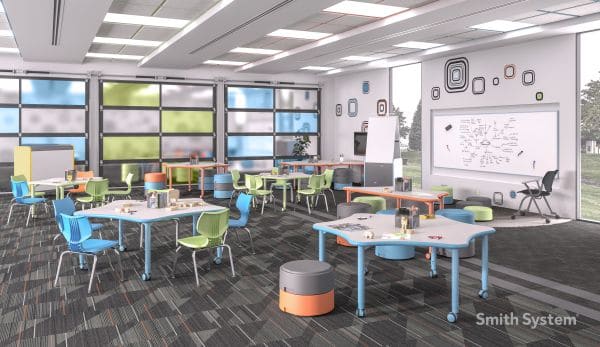Student outcomes are the most relevant factor when it comes to measuring the success of a learning environment.
Though classroom design has an important influence on learning achievement, the majority of time is spent on traditional methods of enhancing the learning progress, such as executing standardized tests, professional growth for educators, and advancement or mediation courses for students.
Thanks to a growing awareness of the profound impact classroom design can have on the educational achievements of students, opinions on classroom design are changing, as educators are making strides toward constructing optimal learning environments with the goal of meeting the educational needs of various groups of students.
Classroom Style
When creating classroom designs suited to enhance the educational experience of all learners, educators are focusing on cultivating student growth in creativity, collaboration, and communication.
Along with the initiative for personalized learning, a core focus of modern classroom design is flexibility. Flexible classroom designs allow learners to make choices, experiment with learning techniques, and ultimately discover how they learn best.
A flexible classroom layout also supplies teachers with a greater capacity to effectively respond to different students’ learning needs. Flexible classrooms usually incorporate some type of group discussion area, a variety of seating options, and a flexible space, which can be adjusted for many specialized activities.
With the central goal of providing the space for students to explore, share, and create collaboratively, flexible classroom arrangements provide the means for a variety of group set-ups and lesson formats in hopes of addressing all students’ needs.
Dr. Mimi Shagaga, a licensed clinical psychologist, says, “Physical environments in the classroom can have a significant impact on learning. Research has indicated that classroom organization, access of supplies, lighting and even the color of a classroom can boost academic achievement levels. Additionally, crowded classrooms with more students have been linked to lower levels of achievement.”
She continues, “Research has also indicated that classrooms with windows, particularly with views of some type of landscape have been linked to better performance on tests. It has also been found that these types of classrooms have led to less mental fatigue and better performance in the areas of attention and focus.”
Collaborative Spaces
Enhancing flexibility means adhering to the educational requirements of all learners and encouraging unity within diverse groups of students.
As a design featuring small tables for group work and shared table-top presentations, the concept of collaborative spaces highlights group learning activities while being flexible enough to ensure all students’ needs are met.
Jennifer Stringer, an education and marketing strategist, says, “An important aspect of classroom design is allowing for flexible configurations and spaces. As adults, we know we might be more comfortable reading in our favorite chair or standing while we work. Students should have those same opportunities. As a classroom teacher, I found that allowing students to choose the spots they found most comfortable to work in helped students concentrate and allowed me to concentrate on facilitating learning, not managing behavior.”
Ability to Move
Research has indicated that allowing time for movement is one of the best means of enabling children to obtain more control over their behavior and immerse themselves in the material they are learning about.
Giving students the option to bounce and turn as they are sitting in class can improve their ability to remain focused throughout the school day. Moveable furniture can be an asset to a flexible classroom, providing learners with the opportunity to learn and retain information more effectively.
Salpy Baharian, co-founder of Teacher.org, says, “In the primary elementary grades, it is imperative to provide opportunities to MOVE. When training new teachers, I would always advise K-2 teachers to create a space for a large rug or carpet near the whiteboard where instruction takes place. Proximity is key. Young students should be close to “action” when new material is being presented.”
She continues, “For example, children are seated on the rug when new material is being taught. Just as kids start to get squirmy, it is time to transition children back to their desks for the extension of learning (guided practice or independent practice). This setup provides opportunities for young students to move. Additionally, the rug allows teachers to be close to their students when new learning occurs. In my years in the classroom, I have seen young children thrive in this classroom design.”
Children with Learning and Attention Differences
When it comes to helping children with learning and attention differences, such as Attention-Deficit Hyperactivity Disorder (ADHD), it is crucial for children to be allowed to learn in a way that aligns with what their minds and bodies need to sustain attention.
Furniture can act as a means of releasing restlessness for children with ADHD and other attention differences. This provides them with a viable way to expend their energy and improves focus levels throughout the school day.
Sharon Saline, clinical psychologist and author, says, “Kids with ADHD and other learning differences benefit from classrooms that help them develop the executive functioning skills they need for academic and social success. Classrooms that are too chaotic or cluttered make it tough for them to focus and monitor themselves. These students are especially sensitive to overstimulation—whether it’s visual, auditory or interpersonal. This means that classrooms that are chock full of decoration—art, maps, charts, etc. can be overwhelming and agitating to them.”
She continues, “Likewise, sitting at tables with peers makes it harder for them to concentrate because they are easily distracted by other kids’ noises, side-talking or movements. Individual desks and walls with some blank spaces help to calm them so they can settle into doing their work more easily.”
Conclusion
Implementing design changes within a classroom can have a profound influence on establishing a positive learning experience for all students.
Increasing flexibility and encouraging exploration, sharing, and creation can dramatically enhance a student’s sense of well-being at school and cultivate a learning environment in which both students and educators can reach their highest potential.
This article is courtesy of Worthington Direct, www.worthingtondirect.com. At Worthington Direct, you will find over 10,000 quality furniture products for your school. Their goal is to make your purchasing job easier by giving you direct access to competitive prices on all types of commercial and institutional furniture products.









